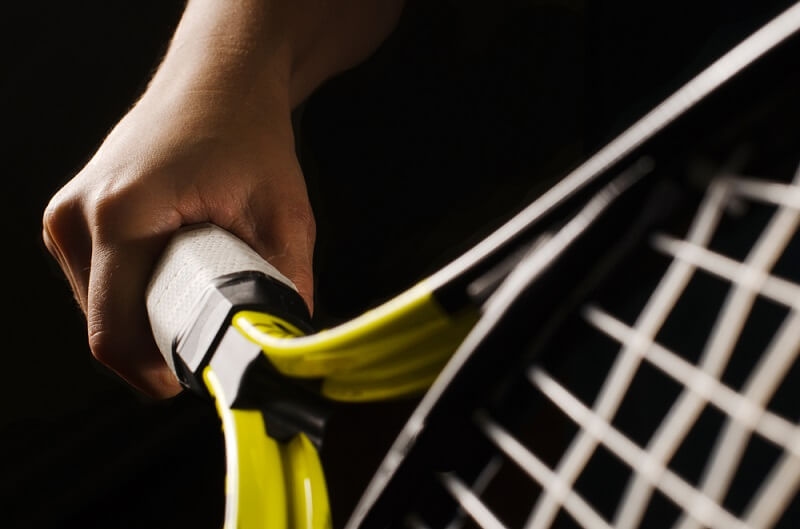
Close
Whether you're a novice on the court or an experienced player aiming for perfection, avoiding common tennis training mistakes can drastically improve your game. Tennis is a sport of precision, agility, and endurance. However, many players, regardless of their skill level, often fall into traps that hinder their progress.
From a grip that's too tight or too loose, to underestimating the importance of proper footwork and shoulder strength, these pitfalls can spell the difference between victory and defeat. This blog post will uncover the most common tennis training mistakes, providing you with strategies to rectify them and enhance your game.
We'll also explore valuable lessons from legends like Roger Federer and delve into the world of table tennis for some cross-disciplinary insights. Join us on this journey towards tennis excellence and become the player you've always aspired to be.

One of the most common mistakes players make is holding the racket incorrectly. This can significantly affect the control, power, and spin you can put into your shots. Grips should be adjusted depending on the type of shot you're taking.
Another common error is inadequate footwork. Good footwork is crucial for getting into the right position quickly to take a shot. Without it, your balance, timing, and shot quality can greatly suffer.
Many players underestimate the importance of a good serve. The serve is the only shot where a player has total control, and an effective serve can give you an early advantage in a point.
Some players tend to play reactively rather than proactively. Instead of planning their shots and points ahead of time, they react to their opponent's moves. This can result in a lack of control over the game's flow and dynamics.
Consistency is key in tennis. Players often make the mistake of not following a regular, disciplined training schedule. This leads to erratic performance and slows down improvement. Regular, focused practice is crucial for mastering techniques and improving performance.
When it comes to perfecting your tennis game, there's much we can learn from the greats, and there are few greater than Roger Federer. Federers skillful play is a testament to his mastery of technique, precision, and footwork. His game exemplifies how avoiding common mistakes can lead to success on the court.
Interestingly, table tennis players also have much to teach us. Despite the difference in scale, table tennis and lawn tennis share fundamental principles. Table tennis demands agility, quick reflexes, and precise shots, all while operating in a smaller, confined space. Incorporating table tennis into your training regime can be an excellent way to hone these skills.
You may also like: Tennis Workout Plan To Make You Fit For Your Matches

The grip is a fundamental part of tennis, and the correct grip can improve your game dramatically. While there are several grips in tennis like Eastern, Western, and Continental, choosing the right one depends on your play style and the type of shot you're taking. Experiment with different grips, and practice transitioning between them during a rally. The more comfortable you are with different grips, the more diverse and unpredictable your game will become.
Quality shots are paramount for success in tennis. A well-placed, powerful shot can put your opponent on the defensive, giving you the upper hand. To improve your shots, focus on three things: timing, swing, and follow-through. Timing is about hitting the ball at the right moment for maximum impact. Swing refers to the motion of your racketsmooth and controlled is always better than fast and chaotic. Finally, follow-through is about continuing the motion of your swing after hitting the ball. This helps maintain control and direction of the shot.
The ready position is a fundamental but often overlooked aspect of tennis. This is the stance you take when waiting for the opponent's return. It involves bending your knees slightly, balancing your weight on the balls of your feet, and holding your racket in front of you. A good ready position allows you to respond quickly and effectively to any shot your opponent makes. It's about staying alert, anticipating the next move, and being prepared to move in any direction.
The power of your shot comes from more than just your armit's generated from your whole body, particularly your core and shoulder blades. Strengthening these areas can add significant power to your shots. Exercises such as rows, pull-ups, and shoulder presses can help build strength in your shoulder blades, while core exercises like planks and sit-ups can enhance your overall power.
Additionally, remember to use your shoulder rotation when striking the ballthis generates more force than just swinging your arm alone.

In tennis, unforced errors refer to mistakes made in situations where a player is not under pressure from their opponent. These mistakes often stem from poor technique, lack of focus, or misjudgment. Unforced errors can give away easy points and shift the momentum of the match in favor of the opponent.
Avoiding unforced errors involves enhancing your focus, patience, and consistency. Practicing mindfulness can help you stay present and focused during the game. Patience is key to not rushing your shots and waiting for the right moment to strike. Lastly, maintaining a regular training schedule can increase your consistency, reducing the chances of unforced errors.
Regardless of the level, there are some rules of thumb all tennis players should remember. For beginners, focus on mastering basic techniques and improving consistency. Club players should prioritize regular practice sessions and start exploring advanced techniques. Advanced players should work on developing their unique style, studying their opponents, and planning their game strategy. Professional players, while continuing to hone their skills, should pay extra attention to physical conditioning and mental preparation.
Similar to tennis, table tennis players often fall prey to common errors. These include poor footwork, improper grip, and underestimating the serve. However, due to the faster pace of table tennis, errors like misjudging the spin of the ball or improper paddle angle are more pronounced. Identifying and working on these areas can lead to a marked improvement in your table tennis game.
Improper grip is a common mistake that can affect your control, accuracy, and power. To correct this, familiarize yourself with different types of grips - Continental, Eastern, and Western. Practice shifting between these grips during a rally. A simple drill to improve grip technique is to practice hitting the ball with each grip type. Over time, this will help you become comfortable with changing grips and enable you to use the correct one for different shots.
Muscle balance is crucial for consistent performance in tennis. It helps maintain proper posture, improves agility, and reduces the risk of injury. Incorporate exercises like squats, lunges, and yoga poses into your training routine to improve your overall balance and stability. Also, work on strengthening your core, as it plays a significant role in maintaining balance during powerful shots and quick movements on the court.
Aggressive shots, when executed well, can drastically shift the game in your favor. These shots force your opponent to play defensively, giving you control over the point. Some examples of aggressive shots include powerful serves, deep groundstrokes, and sharp-angled shots. Practice these shots regularly, but remember, precision and placement are just as important as power. A well-placed shot can be more effective than a powerful one that ends up out of bounds.

Footwork is an essential, yet often overlooked aspect of tennis. Having a swift, efficient footwork technique can drastically enhance your court coverage, shot quality, and reaction times.
When it comes to footwork, the main things to focus on are agility, balance, and speed. Start with the basics - ensure you are always on the balls of your feet, ready to move in any direction. Practice side-to-side movements, forward and backward sprints, and quick directional changes.
Consider drills that incorporate agility ladders, cones, and even jump ropes to increase your foot speed and coordination. Also, learning how to pivot correctly can improve your ability to change direction quickly. Remember, good footwork isn't just about speedit's about being able to position yourself optimally for every shot.
Another important aspect of footwork is recoverygetting back into your ready position after a shot. Effective recovery allows you to cover the court efficiently and prepare for your next shot. Incorporate drills that focus on the 'split step', a short hop that helps you respond quickly to your opponent's shot, into your training regimen.
Lastly, don't forget endurance. Stamina plays a significant role in maintaining good footwork, especially in long matches. Incorporate long-distance running, cycling, or swimming into your fitness routine to build your endurance.
You may also like: Mistakes That Cause Tennis Injuries: How to Avoid Them
Perfecting your tennis game is a continuous journey of learning and growth. Whether you're a beginner or a seasoned player, avoiding common mistakes and implementing correct techniques can make a world of difference in your performance. From mastering the right grip to strengthening your shoulder blades for powerful shots, maintaining your ready position to staying alert to avoid unforced errors, every aspect contributes to your overall game.
Remember to take insights from great players like Roger Federer and even from other racquet sports like table tennis. Most importantly, consistency in your training is the key to improvement. Incorporate these insights into your training regimen, and over time, you'll notice a remarkable improvement in your game. Here's to many more thrilling matches and triumphant moments on the tennis court.
This content was created by AI